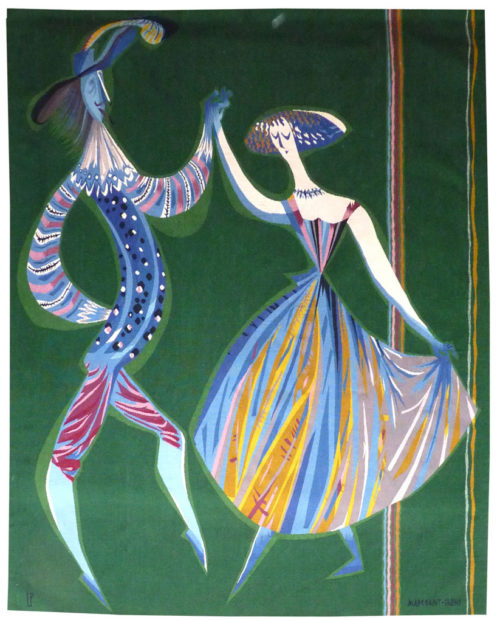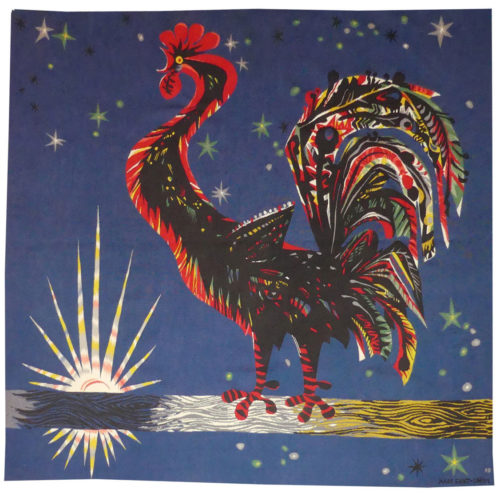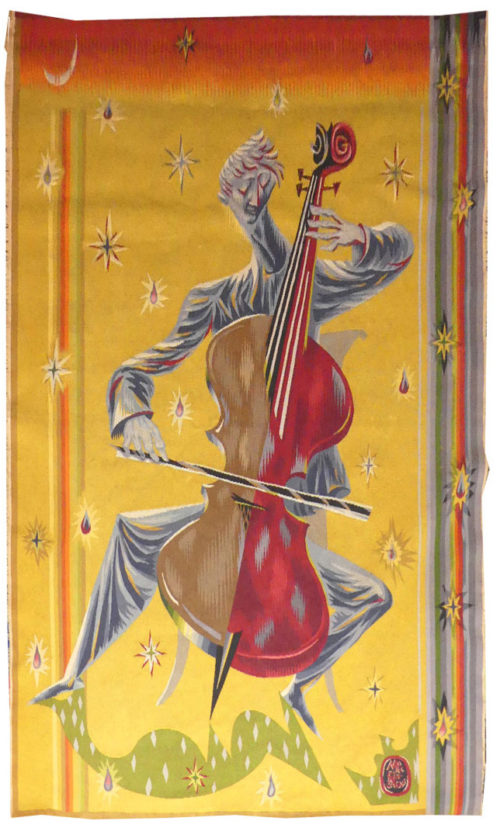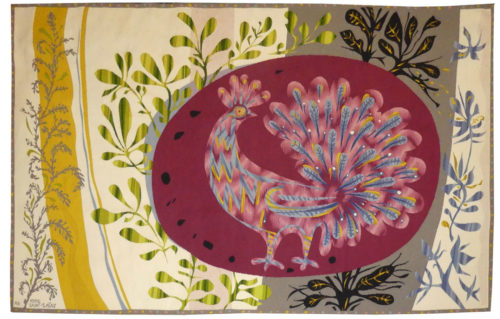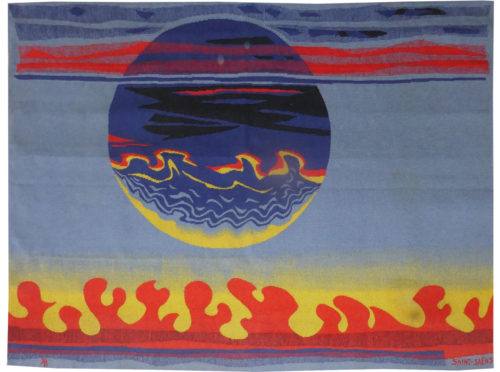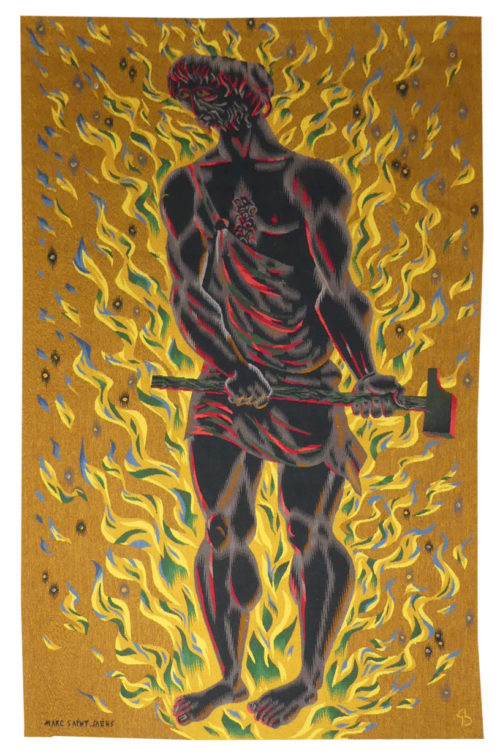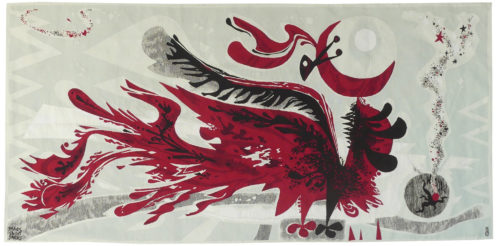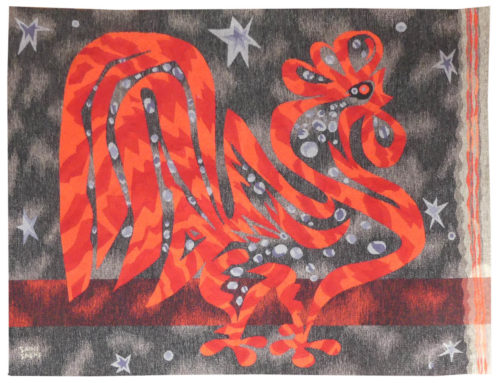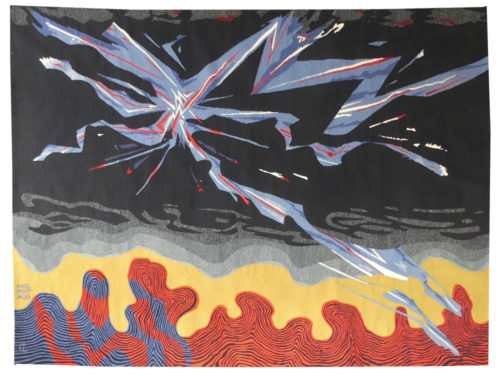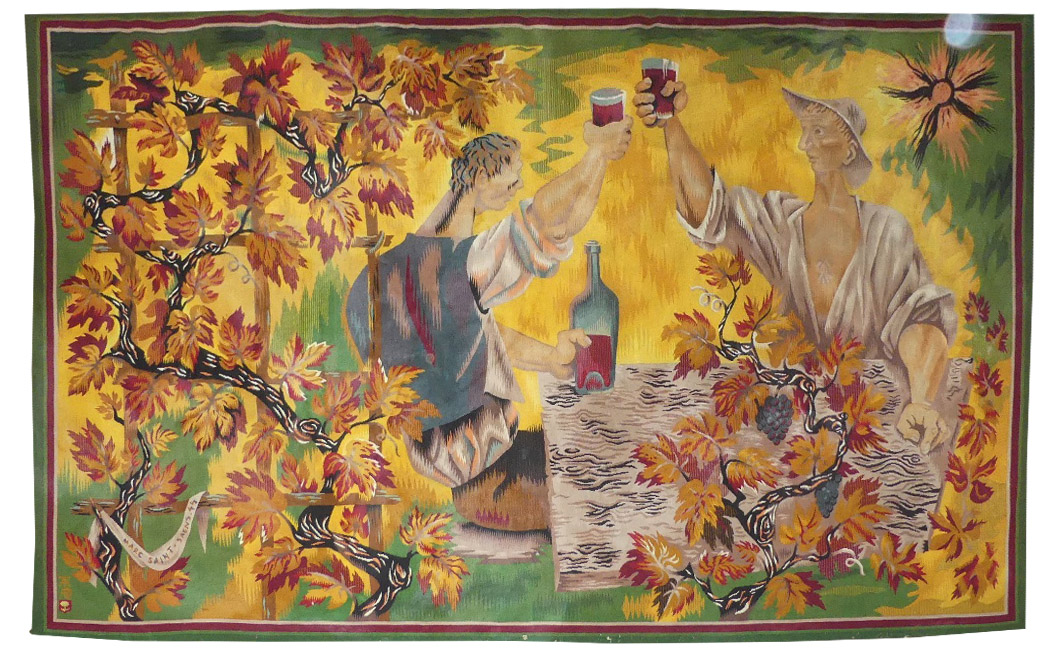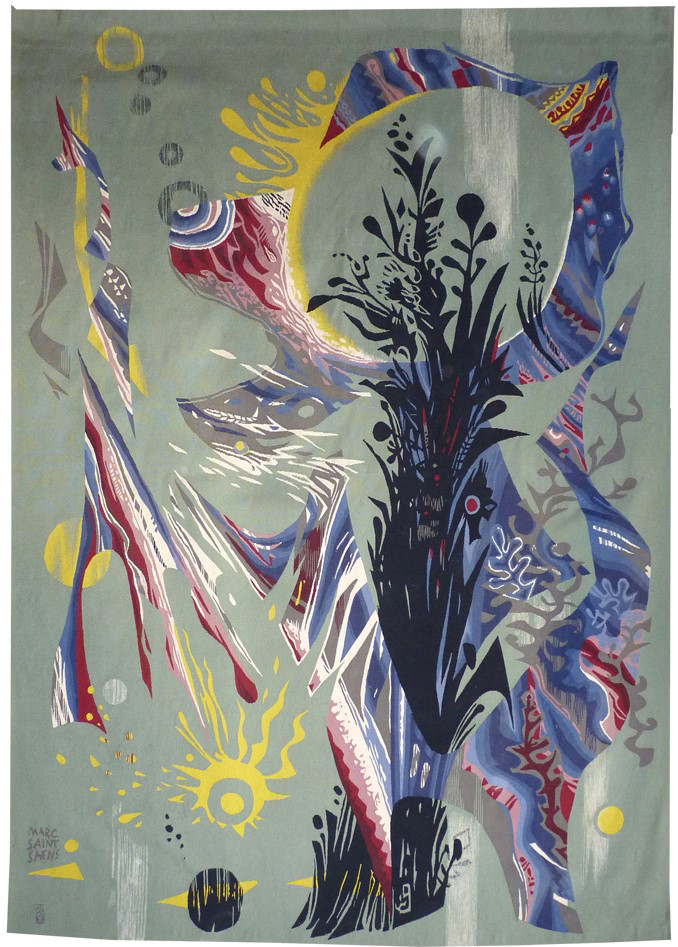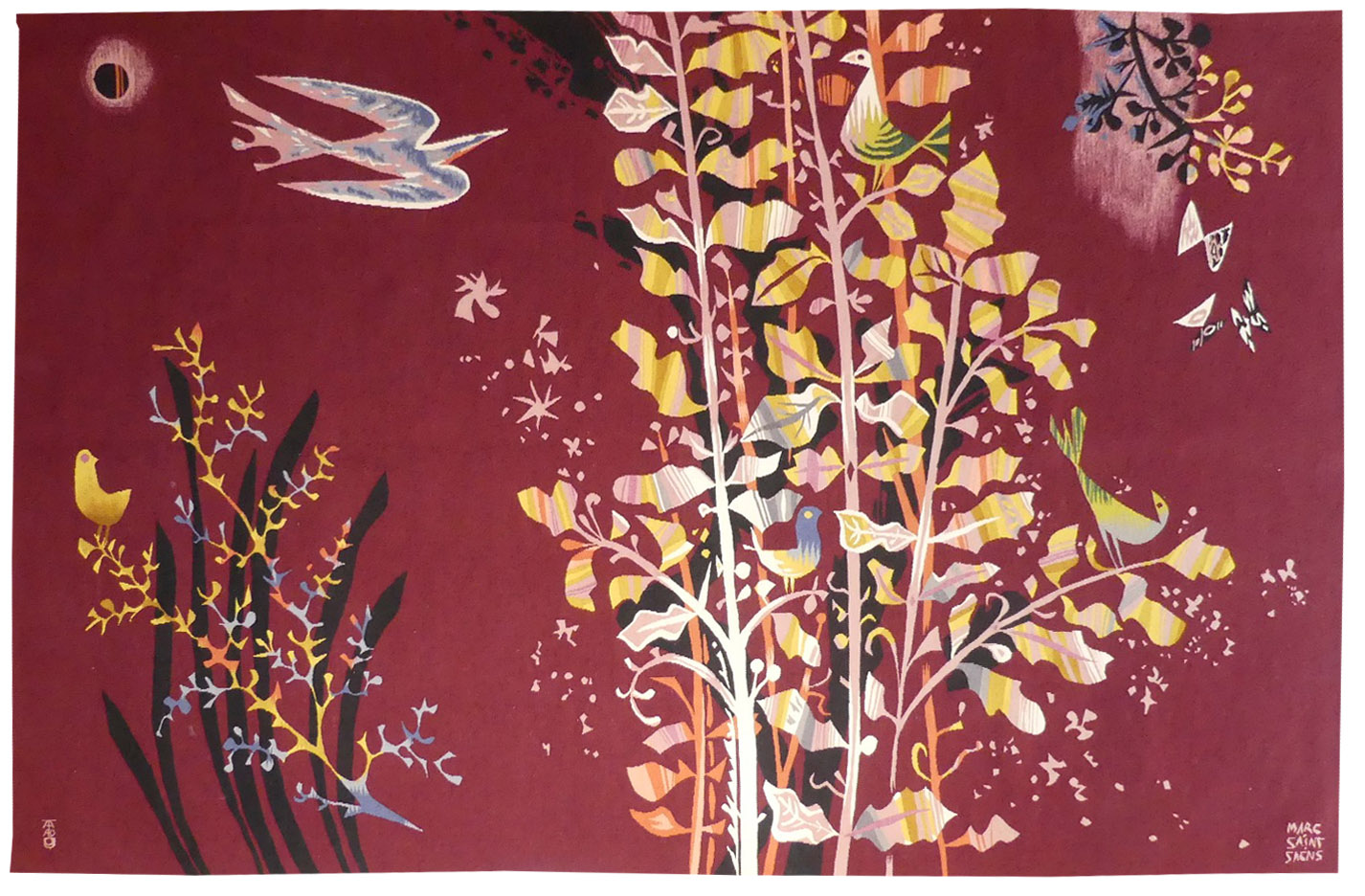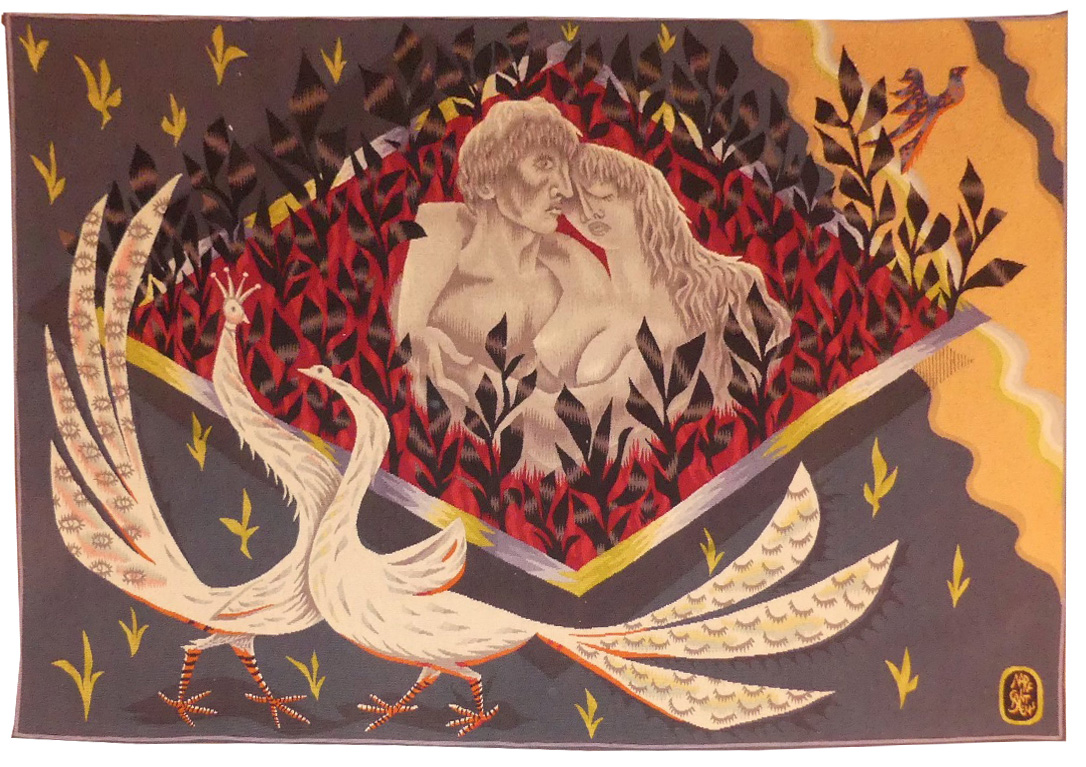-
Le réveille-matin (the alarm clock)
Tapestry woven in the Baudonnet workshop. Complete with signed label. 1959. Lurçat approached Saint-Saëns, originally a painter of murals, in 1940. And during the war the latter produced the first of his allegorical masterpieces, tapestries reflecting indignation, combat, resistance : “les Vierges folles (the foolish virgins), “Thésée et le Minotaure” (Theseus and the Minotaur). At the end of the war, as a natural development he joined up with Lurçat, whose convictions he shared (concerning a simplified palette, outlined cartoons with colours indicated by pre-ordained numbers, and the specific nature of tapestry design...) at the A.P.C.T. (Association des Peintres-cartonniers de Tapisserie). His universe, where the human figure, stretched, elongated, ooccupies an important place (particularly when compared to his companions Lurçat or Picart le Doux), pivots around traditional themes : woman, the Commedia dell’arte, Greek mythology... refined by the brilliance of the colours and the simplification of the layout. His work would evolve later, in the 1960’s, towards cartoons of a more lyrical design, almost abstract where elemental and cosmic forces would dominate. “Saint-Saens who produced a series of birds in 1949 only rarely represented the cock, a recurrent subject for Lurçat. In this piece the cock has no symbolic value but merely announces with gales of crowing and colour the arrival of the new day.” (Exhibition Catalogue Sain-Saëns, œuvre tissé, Aubusson, Musée départemental de la Tapisserie, 1987 p.48) Bibliography : Exhibition catalogue Saint-Saëns, galerie La Demeure, 1970 Exhibition catalogue Saint-Saëns, the tapestries, Aubusson, Musée départemental de la Tapisserie, 1987, ill. p.49 Exhibition catalogue Marc Saint-Saëns, tapestries, 1935-1979, Angers, Musée Jean Lurçat et de la Tapisserie Contemporaine 1997-1998 -
Violoncelle (cello)
Tapestry perhaps woven by the Dumontet workshop. 1947. Lurçat approached Saint-Saëns, originally a painter of murals, in 1940. And during the war the latter produced the first of his allegorical masterpieces, tapestries reflecting indignation, combat, resistance : “les Vierges folles (the foolish virgins), “Thésée et le Minotaure” (Theseus and the Minotaur). At the end of the war, as a natural development he joined up with Lurçat, whose convictions he shared (concerning a simplified palette, outlined cartoons with colours indicated by pre-ordained numbers, and the specific nature of tapestry design...) at the A.P.C.T. (Association des Peintres-cartonniers de Tapisserie). His universe, where the human figure, stretched, elongated, ooccupies an important place (particularly when compared to his companions Lurçat or Picart le Doux), pivots around traditional themes : woman, the Commedia dell’arte, Greek mythology... refined by the brilliance of the colours and the simplification of the layout. His work would evolve later, in the 1960’s, towards cartoons of a more lyrical design, almost abstract where elemental and cosmic forces would dominate. Once more a cartoon which takes music as its theme, a leitmotiv for this artist. Amusingly, and in stark contrast to the importance Saint-Saëns gives to the human figure in his work, the title evokes the instrument rather than the instrumentalist . Bibliography : Exhibition catalogue Saint-Saëns, galerie La Demeure, 1970 Exhibition catalogue Saint-Saëns, the tapestries, Aubusson, Musée départemental de la Tapisserie, 1987 Exhibition catalogue Marc Saint-Saëns, tapestries, 1935-1979, Angers, Musée Jean Lurçat et de la Tapisserie Contemporaine 1997-1998 -
Tapestry woven by the Baudonnet workshop. With label. 1959.Lurçat approached Saint-Saëns, originally a painter of murals, in 1940. And during the war the latter produced the first of his allegorical masterpieces, tapestries reflecting indignation, combat, resistance : “les Vierges folles (the foolish virgins), “Thésée et le Minotaure” (Theseus and the Minotaur). At the end of the war, as a natural development he joined up with Lurçat, whose convictions he shared (concerning a simplified palette, outlined cartoons with colours indicated by pre-ordained numbers, and the specific nature of tapestry design…) at the A.P.C.T. (Association des Peintres-cartonniers de Tapisserie). His universe, where the human figure, stretched, elongated, ooccupies an important place (particularly when compared to his companions Lurçat or Picart le Doux), pivots around traditional themes : woman, the Commedia dell’arte, Greek mythology… refined by the brilliance of the colours and the simplification of the layout. His work would evolve later, in the 1960’s, towards cartoons of a more lyrical design, almost abstract where elemental and cosmic forces would dominate. The number and variety of animals used in his tapestries by Saint-Saëns is not so rich as others of his contemporaries such as Lurçat, Perrot or Dom Robert, principally known for his peacocks. Here the use, as if off the ground, of a similar motif (despite the fact that it more ressembles a cockerel than a peacock) illustrates the variety of solutions employed by the painter-cartonniers of the period. Bibliography : Exhibition catalogue Saint-Saëns, galerie La Demeure, 1970 Exhibition catalogue Saint-Saëns, the tapestries, Aubusson, Musée départemental de la Tapisserie, 1987 Exhibition catalogue Marc Saint-Saëns, tapestries, 1935-1979, Angers, Musée Jean Lurçat et de la Tapisserie Contemporaine 1997-1998
-
Soleil (Sun)
Lurçat approached Saint-Saëns, originally a painter of murals, in 1940. And during the war the latter produced the first of his allegorical masterpieces, tapestries reflecting indignation, combat, resistance : “les Vierges folles (the foolish virgins), “Thésée et le Minotaure” (Theseus and the Minotaur). At the end of the war, as a natural development he joined up with Lurçat, whose convictions he shared (concerning a simplified palette, outlined cartoons with colours indicated by pre-ordained numbers, and the specific nature of tapestry design...) at the A.P.C.T. (Association des Peintres-cartonniers de Tapisserie). His universe, where the human figure, stretched, elongated, ooccupies an important place (particularly when compared to his companions Lurçat or Picart le Doux), pivots around traditional themes : woman, the Commedia dell’arte, Greek mythology... refined by the brilliance of the colours and the simplification of the layout. His work would evolve later, in the 1960’s, towards cartoons of a more lyrical design, almost abstract where elemental and cosmic forces would dominate. In the 1960’s, Saint-Saëns moved towards a more abstract style using bright, acidic and highly contrasted colours, and accentuated his attraction to the grand themes of Nature “the seasons”, “lightning”...) Bibliography : Exhibition catalogue Saint-Saëns, galerie La Demeure, 1970 Exhibition catalogue Saint-Saëns, the tapestries, Aubusson, Musée départemental de la Tapisserie, 1987 Exhibition catalogue Marc Saint-Saëns, tapestries, 1935-1979, Angers, Musée Jean Lurçat et de la Tapisserie Contemporaine 1997-1998Tapestry woven by the Baudonnet workshop. N°1/6. Circa 1970. -
Le feu (Fire)
Lurçat approached Saint-Saëns, originally a painter of murals, in 1940. And during the war the latter produced the first of his allegorical masterpieces, tapestries reflecting indignation, combat, resistance : “les Vierges folles (the foolish virgins), “Thésée et le Minotaure” (Theseus and the Minotaur). At the end of the war, as a natural development he joined up with Lurçat, whose convictions he shared (concerning a simplified palette, outlined cartoons with colours indicated by pre-ordained numbers, and the specific nature of tapestry design…) at the A.P.C.T. (Association des Peintres-cartonniers de Tapisserie). His universe, where the human figure, stretched, elongated, ooccupies an important place (particularly when compared to his companions Lurçat or Picart le Doux), pivots around traditional themes : woman, the Commedia dell’arte, Greek mythology… refined by the brilliance of the colours and the simplification of the layout. His work would evolve later, in the 1960’s, towards cartoons of a more lyrical design, almost abstract where elemental and cosmic forces would dominate. « Le Feu » is the 4th in the series « les Quatre éléments », commissioned by Jansen, woven by Dumontet and exhibited in 1946 at the Musée d’Art Moderne. Myths and allegory were a frequent source of inspiration for the artist at this period : “Orion”, “Diane”, “Thésée et le Minotaure” are all contemporary. Here the muscular figure of a Vulcanite blacksmith whose colour evokes glowing embers in dark relief against a flaming background leaves the observer with a long-lasting impression. Bibliography : Exhibition catalogue La tapisserie française du Moyen-âge à nos jours, Paris, Musée d’art moderne, 1946 Exhibition catalogue Saint-Saëns, Paris, galerie La Demeure, 1970, ill. Exhibition catalogue Saint-Saëns, the tapestries, Aubusson, Musée départemental de la Tapisserie, 1987 Exhibition catalogue Marc Saint-Saëns, tapestries, 1935-1979, Angers, Musée Jean Lurçat et de la Tapisserie Contemporaine 1997-1998Aubusson tapestry woven by the Glaudin-Brivet workshop. With signed label, n°EX. 1945. -
Bel canto
Lurçat approached Saint-Saëns, originally a painter of murals, in 1940. And during the war the latter produced the first of his allegorical masterpieces, tapestries reflecting indignation, combat, resistance : “les Vierges folles (the foolish virgins), “Thésée et le Minotaure” (Theseus and the Minotaur). At the end of the war, as a natural development he joined up with Lurçat, whose convictions he shared (concerning a simplified palette, outlined cartoons with colours indicated by pre-ordained numbers, and the specific nature of tapestry design…) at the A.P.C.T. (Association des Peintres-cartonniers de Tapisserie). His universe, where the human figure, stretched, elongated, ooccupies an important place (particularly when compared to his companions Lurçat or Picart le Doux), pivots around traditional themes : woman, the Commedia dell’arte, Greek mythology… refined by the brilliance of the colours and the simplification of the layout. His work would evolve later, in the 1960’s, towards cartoons of a more lyrical design, almost abstract where elemental and cosmic forces would dominate. If Music as a theme is ever-present in Saint-Saëns’s work, the changes that his style underwent in the 1960’s towards a vision that is both more informal and biomorphic, influenced his treatment of it ; but is not the lyricism evident in this piece ideally suited to the expression “Bel Canto” ? Bibliography : Exhibition catalogue La tapisserie française du Moyen-âge à nos jours, Paris, Musée d’art moderne, 1946 Exhibition catalogue Saint-Saëns, Paris, galerie La Demeure, 1970, ill. Exhibition catalogue Saint-Saëns, the tapestries, Aubusson, Musée départemental de la Tapisserie, 1987 Exhibition catalogue Marc Saint-Saëns, tapestries, 1935-1979, Angers, Musée Jean Lurçat et de la Tapisserie Contemporaine 1997-1998Aubusson tapestry woven by the Tabard workshop. N°4. 1964. -
Coq rouge (red rooster)
Lurçat approached Saint-Saëns, originally a painter of murals, in 1940. And during the war the latter produced the first of his allegorical masterpieces, tapestries reflecting indignation, combat, resistance : “les Vierges folles (the foolish virgins), “Thésée et le Minotaure” (Theseus and the Minotaur). At the end of the war, as a natural development he joined up with Lurçat, whose convictions he shared (concerning a simplified palette, outlined cartoons with colours indicated by pre-ordained numbers, and the specific nature of tapestry design…) at the A.P.C.T. (Association des Peintres-cartonniers de Tapisserie). His universe, where the human figure, stretched, elongated, ooccupies an important place (particularly when compared to his companions Lurçat or Picart le Doux), pivots around traditional themes : woman, the Commedia dell’arte, Greek mythology… refined by the brilliance of the colours and the simplification of the layout. His work would evolve later, in the 1960’s, towards cartoons of a more lyrical design, almost abstract where elemental and cosmic forces would dominate. The theme of the cockerel, already present in « réveille-matin » (the alarm clock) in 1959, is something of a rarity in Saint-Saëns’s work (notably when compared with that of Lurçat). In this case the style has much evolved : the forms are supple and sinuous, the colours vivid, the lines uncluttered as if drawn in (red) chalk on a blackboard. Bibliography : Exhibition catalogue Saint-Saëns, oeuvre tissé, Aubusson, Musée départemental de la Tapisserie, 1987 Exhibition catalogue Marc Saint-Saëns, tapisseries, 1935-1979, Angers, Musée Jean Lurçat et de la Tapisserie Contemporaine, 1997-1998, ill. p.22Aubusson tapestry woven by the Glaudin-Brivet workshop. n°1/6. 1974. -
Eléctricité (electricity)
Lurçat approached Saint-Saëns, originally a painter of murals, in 1940. And during the war the latter produced the first of his allegorical masterpieces, tapestries reflecting indignation, combat, resistance : “les Vierges folles (the foolish virgins), “Thésée et le Minotaure” (Theseus and the Minotaur). At the end of the war, as a natural development he joined up with Lurçat, whose convictions he shared (concerning a simplified palette, outlined cartoons with colours indicated by pre-ordained numbers, and the specific nature of tapestry design…) at the A.P.C.T. (Association des Peintres-cartonniers de Tapisserie). His universe, where the human figure, stretched, elongated, ooccupies an important place (particularly when compared to his companions Lurçat or Picart le Doux), pivots around traditional themes : woman, the Commedia dell’arte, Greek mythology… refined by the brilliance of the colours and the simplification of the layout. His work would evolve later, in the 1960’s, towards cartoons of a more lyrical design, almost abstract where elemental and cosmic forces would dominate. « Lightning » [another title for this cartoon] … bears witness to a new departure for Saint-Saëns, already visible in the 1960’s ; an evocation of cosmic forces [or rather as in this case , physical phenomena] not so much suggested by the drawing’s precision so much as by the strident colours employed…. This tapestry was used for the poster advertising the inauguration of the Aérospatiale Cultural Centre in Toulouse in 1971 » according to Michel Heng, in the exhibition catalogue for the Saint-Saëns exhibition in Aubusson. Bibliography : Exhibition catalogue Saint-Saëns, oeuvre tissé, Aubusson, Musée départemental de la Tapisserie, 1987, ill. p.47 Exhibition catalogue Marc Saint-Saëns, tapisseries, 1935-1979, Angers, Musée Jean Lurçat et de la Tapisserie Contemporaine, 1997-1998Aubusson tapestry woven by the Legoueix workshop. With signed label, n°1/6. 1970. -
Les buveurs (the drinkers)
Lurçat approached Saint-Saëns, originally a painter of murals, in 1940. And during the war the latter produced the first of his allegorical masterpieces, tapestries reflecting indignation, combat, resistance : “les Vierges folles (the foolish virgins), “Thésée et le Minotaure” (Theseus and the Minotaur). At the end of the war, as a natural development he joined up with Lurçat, whose convictions he shared (concerning a simplified palette, outlined cartoons with colours indicated by pre-ordained numbers, and the specific nature of tapestry design...) at the A.P.C.T. (Association des Peintres-cartonniers de Tapisserie). His universe, where the human figure, stretched, elongated, ooccupies an important place (particularly when compared to his companions Lurçat or Picart le Doux), pivots around traditional themes : woman, the Commedia dell’arte, Greek mythology... refined by the brilliance of the colours and the simplification of the layout. His work would evolve later, in the 1960’s, towards cartoons of a more lyrical design, almost abstract where elemental and cosmic forces would dominate. “The original copy of Les Buveurs (The Drinkers) was commissioned by a friend of the artist.. The cartoon of Les Buveurs, of which 8 copies were produced kept recurring like a rotten apple in the correspondance between Tabard and Saint-Saëns, because of the cost of the weaving. Les Buveurs reflects a solid joie de vivre and can be seen as one more emanation of the rich theme of the vine and the Seasons ...” (Exhibition catalogue Marc Saint-Saëns, tapisseries, 1935-1979, Angers, p.26). The thematic contrast with the artist’s previous cartoons is striking : Orion, Thésée, les vierges folles, ... The lightness of touch found here will also be found in Le Braconnier (The Poacher) or Le Bouquet (The bouquet). A copy of this tapestry figured in the 1946 exhibition at the Musée National d’Art Moderne “La Tapisserie française du moyen-âge à nos jours” (n°297) Bibliography : Jean Lurçat, Tapisserie Française, Bordas, 1947, ill. pl.42 Exhibition catalogue Saint-Saëns, galerie La Demeure, 1970 Exhibition catalogue Saint-Saëns, the tapestries, Aubusson, Musée départemental de la Tapisserie, 1987 Exhibition catalogue Marc Saint-Saëns, tapestries, 1935-1979, Angers, Musée Jean Lurçat et de la Tapisserie Contemporaine 1997-1998, ill. p.26 Exhibition catalogue Tissages d’ateliers, tissages d’artistes, dix ans d’enrichissement des collections, Angers, Musée Jean Lurçat et de la Tapisserie Contemporaine, 2004, ill. p.85Aubusson tapestry woven by the Tabard workshop. 1944. -
Ornements (ornaments)
Aubusson tapestry woven in the Tabard workshop. With certificate of origin signed by the artist, n° 4. 1963. Lurçat approached Saint-Saëns, originally a painter of murals, in 1940. And during the war the latter produced the first of his allegorical masterpieces, tapestries reflecting indignation, combat, resistance : “les Vierges folles (the foolish virgins), “Thésée et le Minotaure” (Theseus and the Minotaur). At the end of the war, as a natural development he joined up with Lurçat, whose convictions he shared (concerning a simplified palette, outlined cartoons with colours indicated by pre-ordained numbers, and the specific nature of tapestry design...) at the A.P.C.T. (Association des Peintres-cartonniers de Tapisserie). His universe, where the human figure, stretched, elongated, ooccupies an important place (particularly when compared to his companions Lurçat or Picart le Doux), pivots around traditional themes : woman, the Commedia dell’arte, Greek mythology... refined by the brilliance of the colours and the simplification of the layout. His work would evolve later, in the 1960’s, towards cartoons of a more lyrical design, almost abstract where elemental and cosmic forces would dominate. This cartoon can be seen as belonging to this particular style. Here is an extract from the 1987 catalogue of his works (p37) : “Ornements, a purely decorative tapestry, resembles Dédale, Biologie (property of the Head office of the CNRS), Bel Canto, in its pure and ample style, flowing and lyrical, very close to the painted studies where Saint-Saëns loosed his passion for freely spread colour.” This cartoon was produced in a series of 5. Bibliography : Exhibition catalogue Saint-Saëns, the tapestries, Aubusson, Musée départemental de la Tapisserie, 1987 (tapestry included in the exhibition but not illustrated in the catalogue) Exhibition catalogue Marc Saint-Saëns, tapestries, 1935-1979, Angers, Musée Jean Lurçat et de la Tapisserie Contemporaine 1997-1998 (ill.p 22) Exhibition Catalogue Marc Saint-Saëns, galerie Moulins, PAD 2010 (ill. p.16) -
Oiseaux et feuillages (birds and leaves)
Aubusson tapestry woven in the Tabard workshop. With certificate of origin signed by the artist. 1961. Lurçat approached Saint-Saëns, originally a painter of murals, in 1940. And during the war the latter produced the first of his allegorical masterpieces, tapestries reflecting indignation, combat, resistance : “les Vierges folles (the foolish virgins), “Thésée et le Minotaure” (Theseus and the Minotaur). At the end of the war, as a natural development he joined up with Lurçat, whose convictions he shared (concerning a simplified palette, outlined cartoons with colours indicated by pre-ordained numbers, and the specific nature of tapestry design…) at the A.P.C.T. (Association des Peintres-cartonniers de Tapisserie). His universe, where the human figure, stretched, elongated, ooccupies an important place (particularly when compared to his companions Lurçat or Picart le Doux), pivots around traditional themes : woman, the Commedia dell’arte, Greek mythology… refined by the brilliance of the colours and the simplification of the layout. His work would evolve later, in the 1960’s, towards cartoons of a more lyrical design, almost abstract where elemental and cosmic forces would dominate. ‘[This cartoon] was a success (7 copies) and there are 2 versions: one with a burgundy background, the other with a black background. Once again Saint-Saëns refers to the great tradition of "verdures tapestries" populated by animals and flowers, an art of unpretentious relaxation....’ (Michèle Heng in Exhibition catalogue Saint-Saëns, the tapestries, Aubusson, Musée départemental de la Tapisserie, 1987, p.34) Bibliography : Exhibition catalogue Saint-Saëns, the tapestries, Aubusson, Musée départemental de la Tapisserie, 1987 Exhibition catalogue Marc Saint-Saëns, tapestries, 1935-1979, Angers, Musée Jean Lurçat et de la Tapisserie Contemporaine 1997-1998 -
Le jardin d'amour (the garden of love)
Tapestry, probably woven in Aubusson. 1947. Lurçat approached Saint-Saëns, originally a painter of murals, in 1940. And during the war the latter produced the first of his allegorical masterpieces, tapestries reflecting indignation, combat, resistance : “les Vierges folles (the foolish virgins), “Thésée et le Minotaure” (Theseus and the Minotaur). At the end of the war, as a natural development he joined up with Lurçat, whose convictions he shared (concerning a simplified palette, outlined cartoons with colours indicated by pre-ordained numbers, and the specific nature of tapestry design…) at the A.P.C.T. (Association des Peintres-cartonniers de Tapisserie). His universe, where the human figure, stretched, elongated, ooccupies an important place (particularly when compared to his companions Lurçat or Picart le Doux), pivots around traditional themes : woman, the Commedia dell’arte, Greek mythology… refined by the brilliance of the colours and the simplification of the layout. His work would evolve later, in the 1960’s, towards cartoons of a more lyrical design, almost abstract where elemental and cosmic forces would dominate. ‘Le jardin d'amour’, an evocative allegory of the terrestrial paradise sometimes illustrated in the Middle Ages and the Renaissance, bears witness to the classical references of Saint-Saëns who, in the same year, conceived "Orphée" and "La Comédie italienne" : theatre, ancient myths and biblical references (the “Vierges folles” cartoon also comes to mind) were omnipresent sources of inspiration. Bibliography : Exhibition catalogue Saint-Saëns, the tapestries, Aubusson, Musée départemental de la Tapisserie, 1987 Exhibition catalogue Marc Saint-Saëns, tapestries, 1935-1979, Angers, Musée Jean Lurçat et de la Tapisserie Contemporaine 1997-1998


